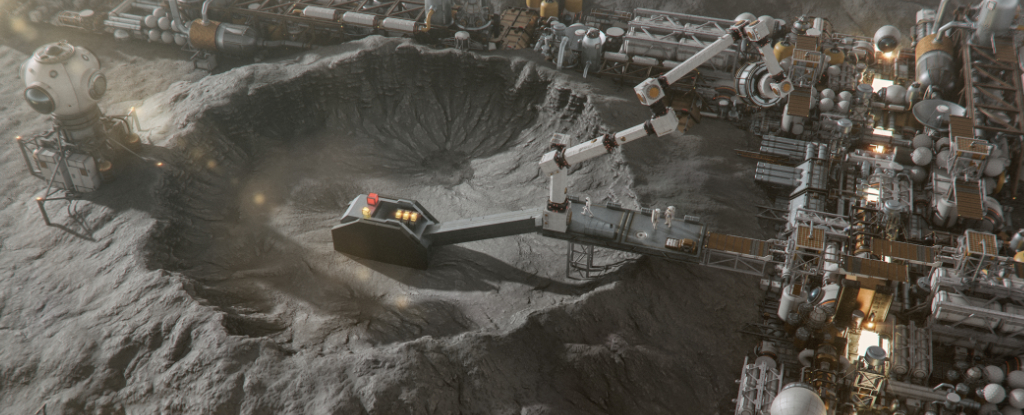The origin of water on earth is an ongoing mystery. There are various hypotheses and theories that explain how the water got here and plenty of evidence to support them.
But water is ubiquitous in protoplanetary disks, and the origin of the water may not be all that mysterious.
A research article in GeoScienceWorld elements shows that other young solar systems have abundant water. In solar systems like ours, water comes with it as the young star grows and planets form. The evidence lies in Earth’s heavy water content, showing that our planet’s water is 4.5 billion years old.
The article is “We drink good 4.5 billion year old water,” and the authors are Cecilia Ceccarelli and Fujun Du. Ceccarelli is an Italian astronomer at the Institute of Planetary Sciences and Astrophysics in Grenoble, France. Du is an astronomer at the Purple Mountain Observatory in Nanjing, China.
The formation of a solar system begins with a huge molecular cloud. The cloud consists mainly of hydrogen, the main component of water. Next come helium, oxygen, and carbon in order of abundance.
The cloud also contains tiny grains of silicate dust and carbonaceous dust. The research article takes us through the history of water in our solar system, and this is where it starts.
Out here in the cold reaches of a molecular cloud, when oxygen hits a speck of dust, it freezes and sticks to the surface.
But water isn’t water until hydrogen and oxygen combine and the lighter hydrogen molecules in the cloud bounce around on the frozen dust grains until they meet oxygen.
When that happens, they react and form water ice – two types of water: regular water and heavy water, which contains deuterium.
Deuterium is an isotope of hydrogen called heavy hydrogen (HDO). It has a proton and a neutron in its nucleus. This distinguishes it from “normal” hydrogen, called protium. Protium has a proton but no neutron. Both hydrogen isotopes are stable and persist to this day, and both can combine with oxygen to form water.
When water ice forms a mantle on dust grains, the authors call this the cold phase, step one in the process they outline in their paper.
Gravity begins to be exerted in the cloud as matter clumps together at the center. More mass falls into the center of the molecular cloud and begins to form a protostar. Some of the gravity is converted into heat, and within a few astronomical units (AU) of the center of the cloud, the gas and dust in the disk reach 100 Kelvin (-280 Fahrenheit).
100 K is bitterly cold by terrestrial standards, only -173 degrees Celsius. But chemically, it’s enough to trigger sublimation, and the ice turns into water vapor. The sublimation takes place in a hot Corino region, a warm envelope surrounding the center of the cloud.
Although they also contain complex organic molecules, the most abundant molecule in Corinos is water.
Water abounds at this point, although it’s all steam. “…a typical hot Corino contains about 10,000 times the water in Earth’s oceans,” the authors said write.
This is the second step in the process outlined by the authors, and they call it the protostar phase.
Next, the star begins to spin, and the surrounding gas and dust form a flattened, rotating disk called a protoplanetary disk. Everything that eventually becomes the planets and other features of the solar system is in this disk.
The young protostar is still gathering mass and its fusion life on the main sequence is far in the future.
The young star generates some heat from tremors on its surface, but not much. So the disk is cold, and the regions furthest from the young protostar are the coldest. According to the authors, what happens next is crucial.
The water ice formed in the first step is gasified in the second step, but condenses again in the coldest areas of the protoplanetary disk. The same population of dust grains is again covered with an ice mantle.
But now the water molecules in this icy mantle contain the history of water in the solar system. “Therefore, dust grains are the guardians of water inheritance,” the authors say write.
This is step three in the process.
In the fourth step, the solar system takes shape and resembles a more fully formed system. All the things we’re used to, like planets, asteroids, and comets, are beginning to form and take their orbits. And what are they from? Those tiny dust grains and their twice frozen water molecules.
This is the situation we are in today. While astronomers can’t travel back in time, they’re getting better at observing other young solar systems and finding clues to the whole process. Earth’s water also contains a crucial clue: the ratio of heavy water to normal water.
Some details are omitted from the simple explanation given so far. If water ice forms in step one, the temperature is extremely low. This triggers an unusual phenomenon called super-deuteration. Superdeuteration introduces more deuterium into the water ice than at other temperatures.
Deuterium was only formed in the seconds after that Big Bang. Not much of it was made: just one deuterium for every 100,000 protium atoms.
This means that if the deuterium were evenly mixed with the water of the solar system, the abundance of heavy water would be expressed as 10-5. But there is more complexity to come.
In a hot Corino, the fullness changes. “In hot Corinos, the HDO/H2The O ratio is just under 1/100,” the authors say to explain. (HDO are water molecules containing two deuterium isotopes, and H2O is normal water, which contains two protium isotopes.)
There is more extremity. “To take things even more extreme,” according to the authors to explain“the doubly deuterated water D2O is 1/1000 with respect to H2O, about 107 times larger than what would be estimated from the D/H element abundance ratio.
The ratios contain such large amounts of deuterium because of superdeuteration. The moment ice forms on the surfaces of the dust grains, an increased number of D atoms compared to H atoms end up on the grain surfaces.
The detailed chemical explanation is beyond the scope of this article, but the conclusion is clear.
“There are no other ways to conserve this large amount of heavy water in hot corinos or in general,” the authors said write. “Hence, abundant heavy water is a hallmark of water synthesis in the cold molecular cloud clump during the STEP 1 era.”
The important thing so far is that there are two episodes of water synthesis. The first happens when the solar system hasn’t formed yet and is just a cold cloud. The second is when planets form.
The two occur under different conditions, and those conditions leave their isotopic imprint in the water. Water from the first synthesis is 4.5 billion years old, and the question is, “How much of this ancient water has reached Earth?”
To find out, the authors observed the only two things they could: the total amount of water and the amount of deuterated water.
As authors put it“…namely, the ratio of heavy to normal water, HDO/H2O.”
More than enough water has been created to account for the water of the earth. Remember that the amount of water in the hot Corino was 10,000 times greater than Earth’s water and its HDO/H2O ratio differs from the water formed in the initial plume.
How much of the Corino water reached the earth? A hint can be found when comparing HDO/H2O values in earth water with those of hot Corinos.
Hot corinos are the only place we have observed HDO in nascent solar-like planetary systems. In previous research, scientists compared these ratios to ratios in objects in our solar system — comets, meteorites, and Saturn’s icy moon Enceladus.
So you know that the abundance of heavy water on Earth, the HDO/H2O ratio, is about ten times larger than in the universe and at the beginning of the solar system.
“Heavy water on Earth is about ten times larger than the elementary D/H ratio in the universe and consequently at the birth of the solar system in the so-called solar nebula,” the authors say to explain.
The results of all this work show that between 1 and 50 percent of the water on Earth came from the early stages of the birth of the solar system. That’s a wide range, but it’s still a significant piece of knowledge.
the authors pack things in their conclusion.
“The water in comets and asteroids (from which the vast majority of meteorites originate) was also inherited in large quantities from the beginning. Earth likely inherited its primordial waters mostly from planetesimals, which are said to be the progenitors of the asteroids and planets that formed Earth, rather than from the comets that rained down on them.”
Cometary delivery is another hypothesis for Earth’s water. In this hypothesis, frozen water from beyond the freezing line reaches Earth when comets are perturbed and is sent into the inner solar system by the frozen Oort Cloud. The idea makes sense.
But this study shows that may not be true.
But it still leaves questions unanswered. It doesn’t explain how all the water reached the earth. But the study shows that the amount of heavy water on Earth is at least the beginning of finding out.
“In summary, the amount of heavy water on Earth is ours Ariadne threadthat can help us get out of the maze of all the possible paths the solar system might have taken,” they explain.
Earth’s water is 4.5 billion years old, just like the title of the article says. At least part of it. According to the authors, planetesimals likely delivered it to Earth, but how exactly that happens isn’t clear. There’s a lot more complexity scientists need to go through before they can figure this out.
“The subject is quite complicated because the origin and development of water on Earth is inevitably linked to other important participants on this planet, e.g. B. carbon, molecular oxygen and the magnetic field,” say the authors write.
These things are all related to the origin of life and the origin of worlds. Water likely played a role in the formation of the planetesimals that brought it to Earth. Water likely played a role in sequestering other chemicals, including the building blocks of life, on bodies of rock that brought them to Earth.
Water is at the heart of everything, and by showing that part of it dates back to the dawn of the solar system, the authors have provided a starting point for exploring the rest.
“Here we have presented a simplified early history of water on Earth based on the latest observations and theories,” she says write.
“A good chunk of terrestrial water probably formed at the very beginning of the solar system’s birth, when it was a cold cloud of gas and dust that was frozen and conserved during the various steps that led to the formation of planets, asteroids, and comets and was eventually transferred to the nascent earth.
“How the last passage happened is another fascinating chapter,” they said conclude.
This article was originally published by universe today. read this original article.





